
Associate professor at Ecole Normale Superieure (ENS Paris)
The study of turbulence is one of the most active research area. We developed several laboratory experiments in order to adress various questions related to turbulence, like the transport properties of turbulent flows, the dimensionality of turbulence or its statistical properties.
Turbulent transport: A long-standing question in fluid
mechanics is to understand how angular momentum is transported by a
turbulent flow. This question is also crucial for several celestial
bodies. For instance, the exact mechanism by which the huge
acccretion rates around black holes are generated is still
unknown. Similarly, stellar interiors generally show rotation rates
much slower than what is predicted by classical theories. I am
therefore interested in the turbulent transport of angular momentum
using both experimental and theoretical approaches.

The MagnetoRotational Instability (MRI) is a fluid
instability arising in flows when the angular
velocity decreases outward and a magnetic field is
applied. It is currently the best candidate to explain
angular momentum transport in accretion disks around
stars and black holes.
Gissinger et al, Phys.Fluids
24,074109 (2012)
Roach et al, Phys.Rev.Lett.
108,154502 (2012)
The KEPLER experiment is a laboratory experiment
designed to study the transport of angular momentum by the
turbulence generated in a thin disk. The flow of an
electrically conducting fluid (Galinstan) is generated in
a thin disc under the action of a vertical magnetic field
and a radial current. The video shows the motion of the
liquid metal in the case of a free surface. This
experiment reproduces many aspects of astrophysical
accretion disks, including the generation of a Keplerian
rotation rate and an efficient transport of angular
momentum outward.
Vernet et al, J. Fluid. Mech.
924,A29 (2021)
Vernet et al, Phys. Rev. Lett. (2022)

Tayler-Spruit dynamo: Stellar observations have recently
revealed that many stellar cores spin much slower that they ought to
according to model predictions. This important mismatch betrays the existence of a powerful yet
unknown mechanism for angular momentum transport in radiative stellar
layers. This picture shows one of our global numerical modeling of a
stellar interior in which a very strong toroidal magnetic field (in
blue) is generated in a stably-stratified radiative zone. This magnetic field then trigger magnetohydrodynamic
turbulence and significantly enhance the transport of angular momentum
compared to hydrodynamic processes, flattening the stellar rotation
profiles. Because the magnetic
field is deeply seated in the star internal layers, it is screened by
the thick stellar outer layers, suggesting that radiative stars known so far as
nonmagnetic may in fact harbor strong, undetected dynamos deep under
the surface !
Petitdemange, Marcotte, Gissinger, Science (2023)
Energy cascade and coherent structures in turbulent flows:
In many fluid systems, energy transfer across different scales is
governed by the dimensionality of the flow and the nonlinear
interactions between these scales. For example, when the flow is
strongly constrained in one direction (such as in rotating flows, thin
layers, or in the presence of a magnetic field) 2D turbulence can
emerge, characterized by the transfer of energy towards larger
scales. Conversely, a small number of capillary waves interacting
nonlinearly can produce a direct 3D cascade of energy. Occasionally,
organized and coherent structures, phase-correlated across the entire
system, emerge within the chaotic turbulent flow, following mechanisms
that are not well understood. Here are a few examples of the
phenomena we are studying in this area.

The FLUIDICS (Fluid Dynamics in Space) experiment is a wave turbulence
experiment conducted in the International Space Station and in
parabolic zero-gravity flights. This allows to study turbulence of
capillary waves at the air-water interface in
weightlessness. Capillary waves are excited in a spherical container
partially filled with water and undergoing sinusoidal or random
oscillations. The fluctuations of the interface, recorded with two
capacitive probes are analyzed by means of the frequency power
spectrum of wave elevation. For high enough forcing amplitudes, we
report power-law spectra with exponents close to the prediction of
weak wave turbulence theory.
Berhanu et al,
EPL(2020)
>
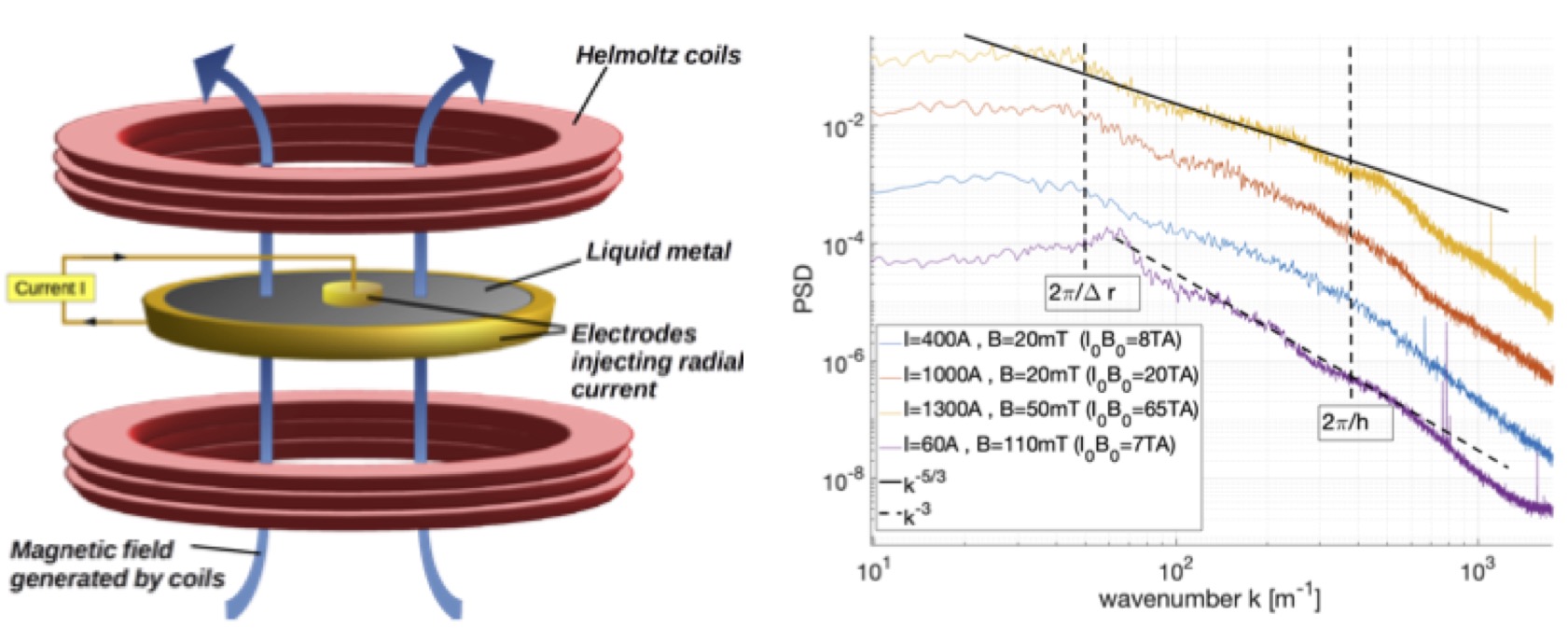
In the KEPLER experiment described above, a
bi-dimensional turbulent flow can be generated when a very
strong magnetic field is applied to the system. In this
case, an inverse cascade of energy is observed, travelling
from small scale to large scale. When the energy reaches
the largest scale (the diameter of the disk), it
condensates and generates large scale vortices than can exhibit low-dimensional behavior.

In a Von-Karman type laboratory experiment, we drive
a shear flow in an annular channel. Although
strongly turbulent, the velocity field displays
random reversals of one of its component. Power
spectra of the velocity field exhibit a 1/f power
law (Flicker noise) on several decades. It can be
shown that the emergence of this Flicker noise can
be related to the existence of coherent structures
in the flow: a continuous transition between two
different types of Flicker noise is observed as the
equatorial symmetry of the flow is broken, in
agreement with theoretical predictions.
Pereira et al,
Phys. Rev. E (2019)
Energy conversion and the development of advanced energy technologies are crucial for addressing the growing global demand for efficient and sustainable energy solutions. Part of our research focuses on energy transformations in fluids, particularly regarding the mediation of energy conversions by fluid instabilities and the development of new technological applications. Here are a few examples, in the areas of liquid thermoelectricity, thermoacoustic cooling, and electromagnetic pumps.
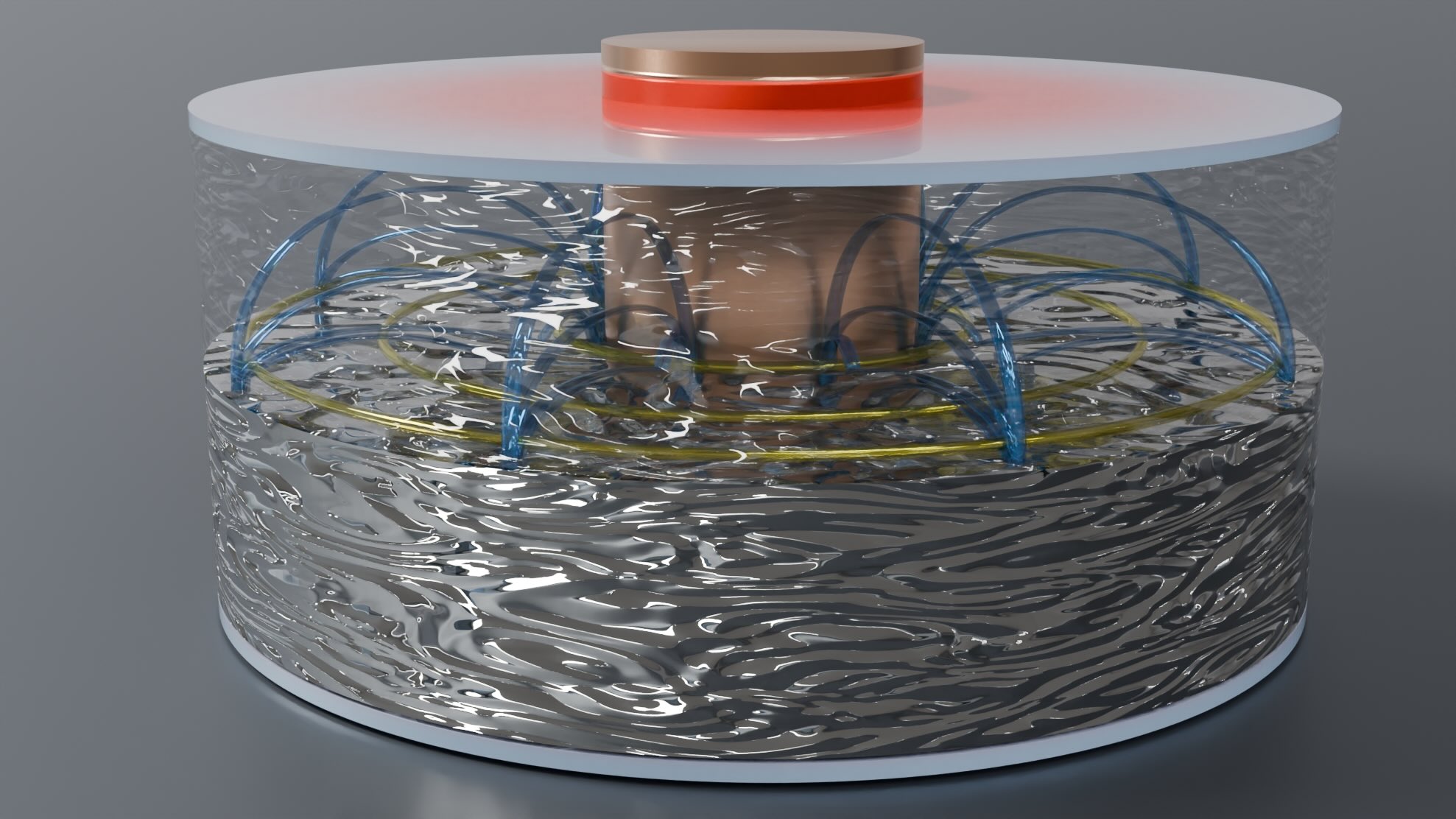
Liquid thermoelectricity: the Seebeck effect is the conversion of heat into electricity, generally achieved by thermoelectric devices using solid electrical conductors or semi-conductors. We described the first evidence of thermoelectricity at the interface between two conductors liquids at room temperature, gallium and mercury. The liquid nature of the interface significantly alters the usual temperature distribution, resulting in an abnormally high current density (50 times higher than conventional solid-state devices) near the boundaries. In the bulk, this new type of thermoelectric current interacts with a magnetic field to produce efficient thermoelectric pumping of fluids. This new effect could play an important play in a number of technological systems, for example by increasing the efficiency of liquid metal batteries or providing efficient cooling of electronic components. Vernet et al, PNAS(2024)

Electromagnetic pumps: electromagnetic induction pumping of electrically conducting fluid is a very important component of the metallurgical industry. We have studied the stability of such flows both experimentally and numerically. In the experiment (left), a liquid metal (GaInSn) is confined between two concentric cylinders and subject to rotating magnetized discs, generating an electromagnetic forcing similar to the one used in electromagnetic pumps. Results indicate a driving of the fluid in good agreement with theoretical predictions. For some parameters, it is possible to observe unstable regimes, characterized by some intermittency of the flow. In the numerical simulations (right), the flow instability occurring in electromagnetically driven flows yields a surprising behavior : in a large region of the fluid domain, the fluid moves backward compared to the propagation of the driving electromagnetic wave, eventually leading to a strongly chaotic and turbulent states. The figure shows the axial velocity in the r-phi plane. Note the strongly negative velocity close to the inner cylinder. This behavior, which seems quite general may explain some properties of large scale electromagnetic pumps Rodriguez-Imazio et al, Phys. Fluids(2016a),Gissinger et al, Phys. Fluids(2016b), Reddy et al, Phys. Rev. Fluids(2018)
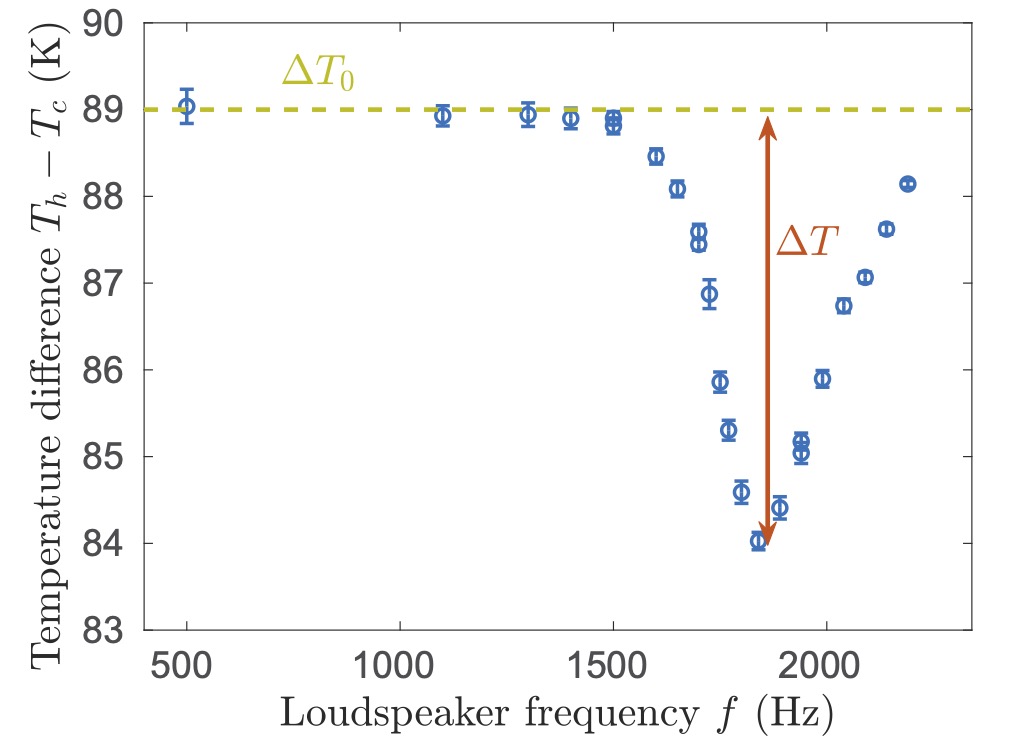
Thermoacoustic cooling : In the absence of natural convection, such as in a zero-gravity environment, efficient heat transfer must rely on externally forced flows. Thermoacoustic cooling, which converts sound waves into heat, offers several advantages over traditional methods. Unlike conventional fans, piezoelectric transducers used in thermoacoustic systems possess properties like virtually infinite lifespan and the absence of moving parts, making them highly reliable. In this experimental study, we reported a thermoacoustic regime where acoustic waves generate large amplitude flow motions in a stratified gas. We showed that heat transfer can be significantly enhanced by sound waves, in quantitative agreement with recent theoretical predictions. Michel and Gissinger, Phys.Rev. Applied (2021),
Astrophysical fluid dynamics deals with the application of fluid dynamics to the motion of fluids encountered in space, such as planetary or stellar interiors, accretion disks and galaxies. Thanks to the growing amount of telescope observations and space missions in recent years, whole sections of the theory of such flows are now actively debated. In our group, we combine laboratory experiments, theory and numerical modeling to understand the mechanisms involved in some of these astrophysical systems.
Hydrodynamics of ocean worlds: it is now very
clear that subsurface oceanic worlds are ubiquitous. For
instance, it is believed that a vast ocean of salty water is
present beneath the surface of several moons and planets of
the solar system (Ganymede, Europa, Enceladus, Ceres, Titan,
etc). Although this is perhaps the most common type of oceanic
world, hydrodynamics of such subsurface oceans remains mostly
unknown. I recently started a project aiming to develop a unified
oceanography model for such subsurface oceans.
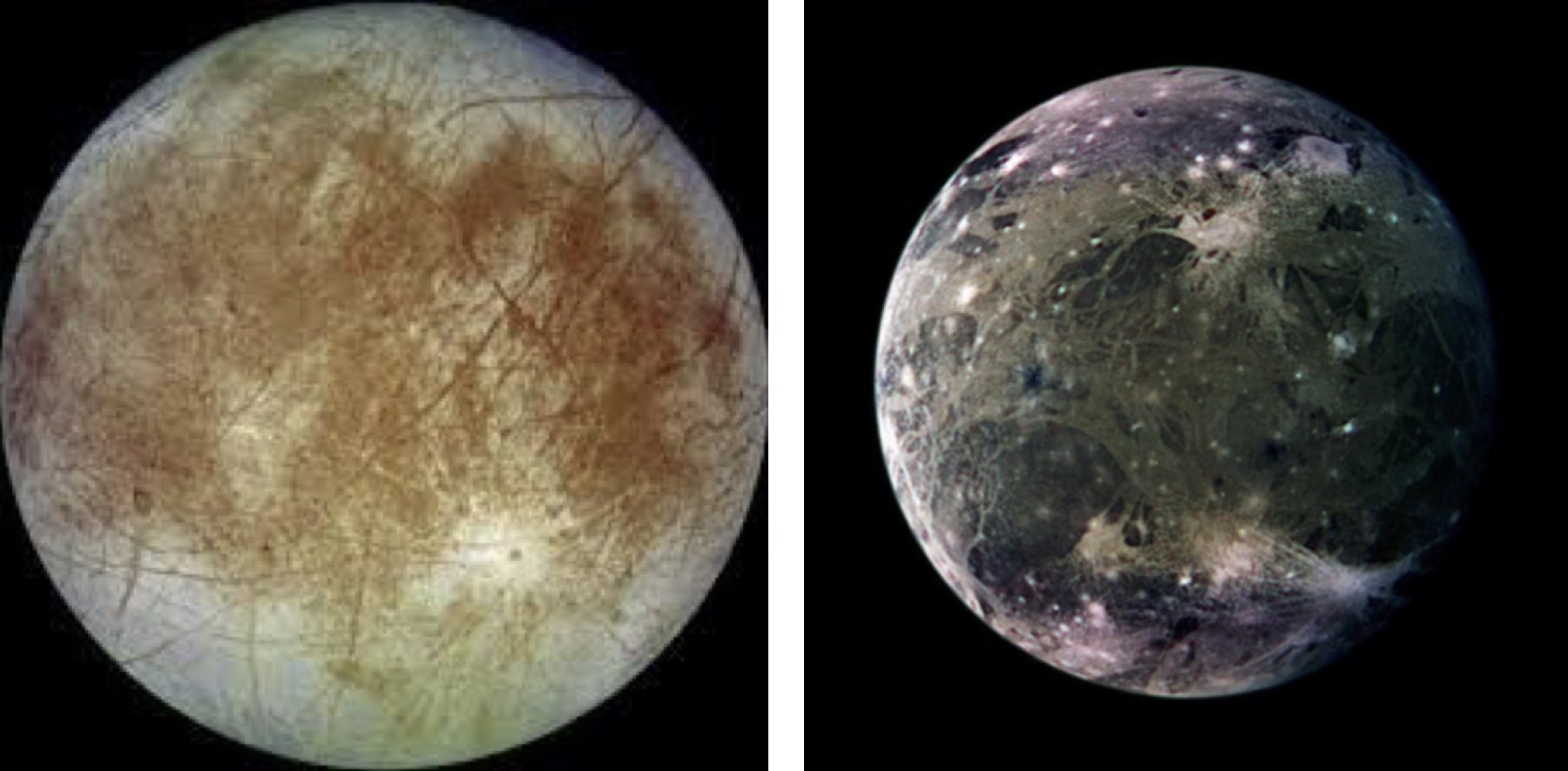
Astrophysicists strongly suspect that most of the
ocean worlds in the solar system involve a deep layer of salty water
under the ice crusts of these planets. This is probably the case for
Ganymede and Europa shown here. A full oceanographic model of these
subsurface oceans may help understanding the intriguing geology of
Europa's surface.
Gissinger et al,
Nature Astronomy (2019)
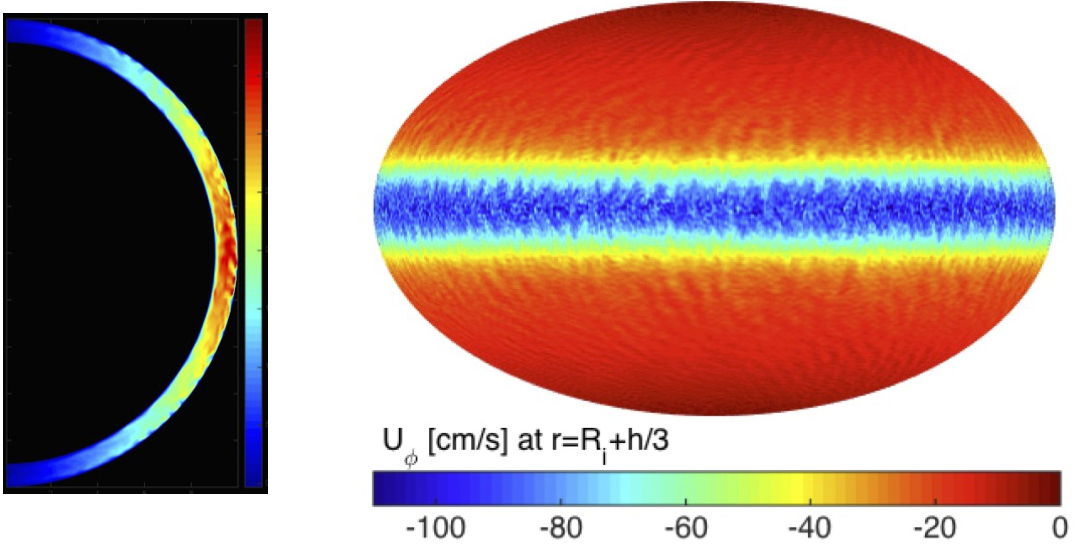
Our recent simulations show that
Jupiter's moons behave like gigantic electromagnetic pumps: as the
huge magnetic field of the parent planet Jupiter rotates, it generates
an electromagnetic force on the ocean, driving an oceanic jet in the
equatorial plane. The numerical simulations predict that this westward jet might reach a
few cm/s on Europa, strong enough to contribute to the formation of
the cracks observed at the surface of the moon. In addition, induced
electrical currents produce a moderate Joule heating at the poles of
the moons, which reinforce tidal heating and might explain the recent
observations of water vapour in the polar region of Europa.
.
Gissinger et al,
Nature Astronomy (2019)
Tornadoes and waves:
Part of our activity focuses on the study of
atmospheric and oceanic vortex motions, such as tornadoes and
cyclones, and their complex interactions with turbulence,
waves, and instabilities. We use laboratory
experiments to study the stability of such flows and the
associated wave dynamics, hoping to get a better understanding of these
powerful phenomena and their impact on weather patterns and
climate systems.
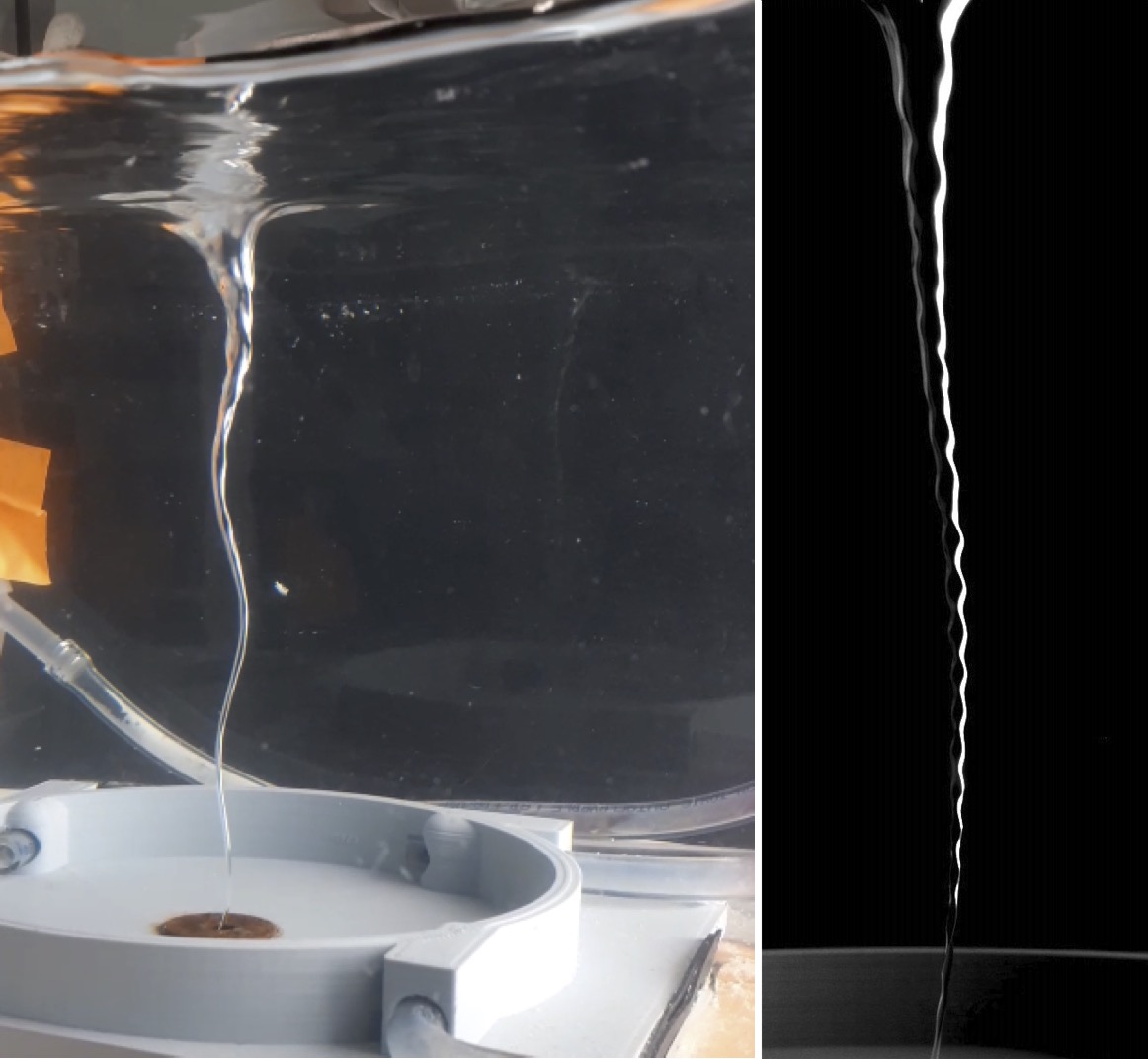
When a coherent vortex is generated in a fluid, some waves can propagate along the vorticity filament. These so-called Kelvin waves are guided by the core of the vortex and have been widely studied theoretically. In this experiment, we study the generation and propagation of Kelvin waves along a bathtub vortex and how these waves influence the formation and behaviour of tornadoes.
Magnetic field generation: Part of my activity is to explore new mechanisms for the generation of planetary magnetic fields, such as the possibility of centrifugal instability in planetary interiors or the existence of new induction processes related to inhomogeneities of the fluid properties.
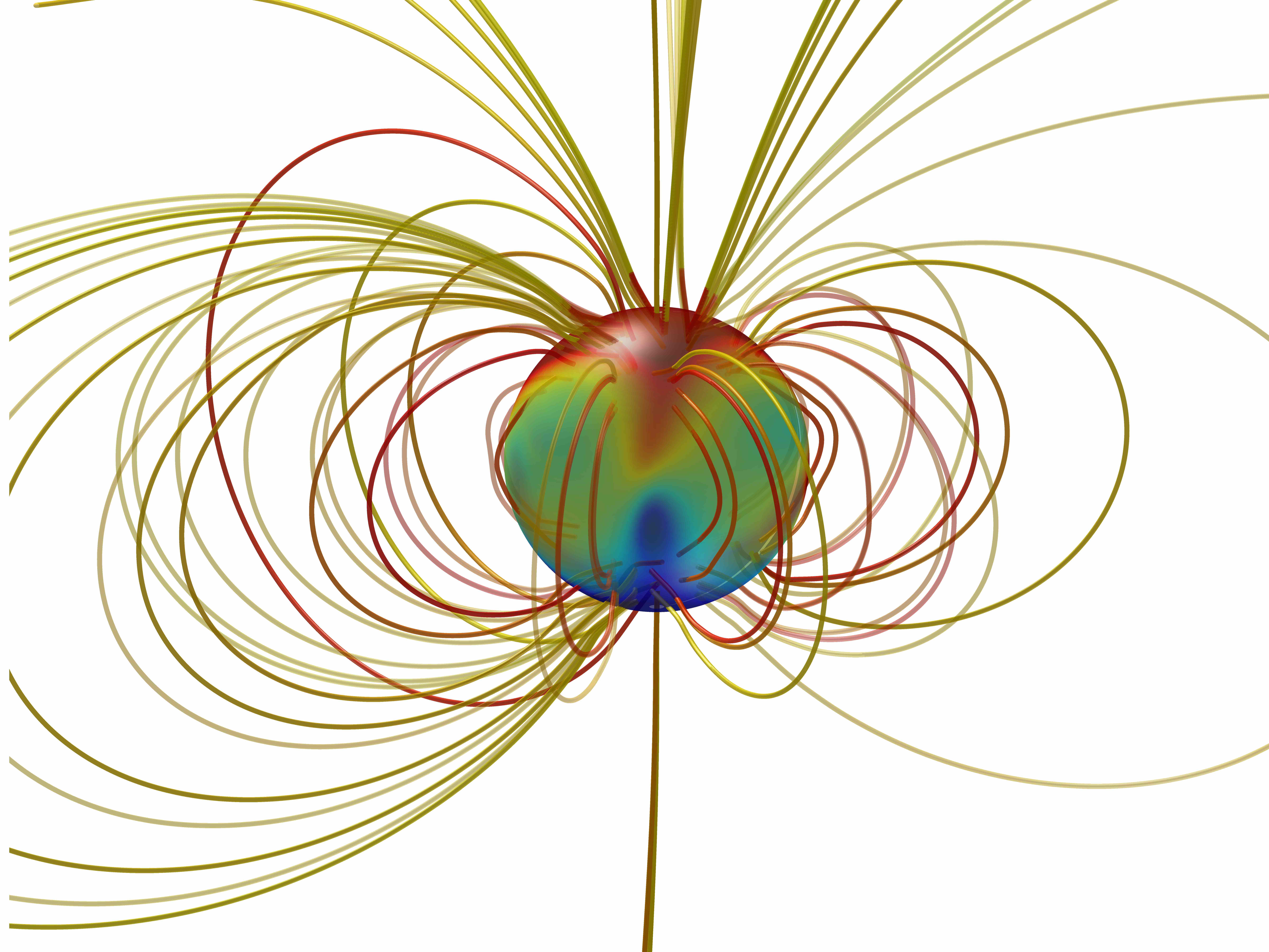
This picture shows the dipole
field generated at the core-mantle boundary in one of our
geodynamo simulations. In presence of a slightly
equatorially asymmetric heat flux, the dipole field
reverses its polarity chaotically. It can
also be shown that fluctuations of the electrical
conductivity (due to variations of temperature in the core
for instance) act as a new source for such astrophysical
magnetic fields.
Gissinger et al, PRL 108,154502 (2012)
Petrelis et al, PRL (2016)

Schematic view of the
VKS (Von Karman Sodium) dynamo experiment, which aims to
reproduce the generation of magnetic fields in planets and
stars. 50 liters of liquid Sodium are put in motion by two
counter-rotating discs driven by 300kW motor power. When
the discs rotate sufficiently fast, a magnetic field with
dipolar symmetry is self generated, reaching approximately
50 Gauss. When the discs in the VKS
experiment rotate at different speed, several dynamical
regimes are observed, including field reversals in which
the magnetic field randomly switches between two symmetric
solutions B and −B, similarly to the Earth’s magnetic
field.
VKS Collaboration page

Most of the galaxies have a coherent large scale
magnetic field. The flow of the interstellar medium presents all the
typical ingredients needed for dynamo action, i.e. differential
rotation and kinetic helicity. I worked on a simple model aiming to
explain the magnetic field of galaxies. This model is based on the
so-called alpha-omega dynamo, and involve the supernovae exploding
in the galaxy as a source of helical motion at small scale.
Numerical simulations of this simple model are able to reproduce
most of the characteristics of the galactic field, such as the
quadrupolar structure or the spiralling properties of the magnetic
field lines.
Gissinger et al, M.N.R.A.S., 394 (2008)
I also work on various non-linear problems, ranging from low-dimensional behavior in fluid dynamics to chaotic motions of mechanical systems. In general, one expects turbulent flows to show a very complex behavior, due to the infinite number of degrees of freedom. Yet, several turbulent systems, MHD or not, exhibit low-dimensional dynamics involving chaotic reversals between two symmetrical states. I work on deterministic or stochastic models aiming to understand such complex behaviors, using only a few modes in interaction.

The figure shows trajectories in phase
space (strange attractor) of a new deterministic 3-modes model
describing the chaotic inversions of the magnetic field of the
Earth. Compared to similar systems (like The Lorenz model for
instance), this new model produces chaotic reversals much
closer to the polarity inversions observed for Earth or VKS
laboratory dynamos. This is due to the particular type of
chaos ('crisis-intermittency') which is generated. Here,
reversals results from the interaction between a symmetrical
and an antisymmetrical magnetic mode, coupled through an
antisymmetric velocity field.
Gissinger, EPJB
85,vol.4 (2012)
Gissinger et al, PRL
101, 144502 (2008)

Here is a simple experimental study of the motion of
magnetized beads driven by a travelling wave magnetic
field. A bead moves on a flat surface under the effect
of a traveling magnetic wave created by 16 Neodymium
magnets disposed with a regular spacing along a circle
located on a rotating disc. For sufficiently large wave
speed, one observes a backward motion, in which the
sphere can move in the direction opposite to the driving
wave. We show that the transition to this new state is
strongly subcritical and can lead to chaotic motion of
the bead. These results can be understood in the framework
of a model based on the interplay among solid friction,
air resistance and magnetic torque.
Gissinger, EPL
112,5 (2015)
For some parameters, the counter-propagation of the
sphere submitted to a travelling magnetic field can be
one order of magnitude faster than the driving wave
speed. In the beginning of the movie, the magnetic
sphere stays above one magnet of the disc (red circles
on the rotating disc), thus achieving a forward
synchronous translation with no rotation. After a small
perturbation (here my finger), there is transition to a
backward translation associated to synchronous angular
rotation. Note that the backward motion, quite
counter-intuitive, is more than ten times faster than
the synchronous motion, due to the effect of wall friction !
Gissinger, EPL
112,5 (2015)